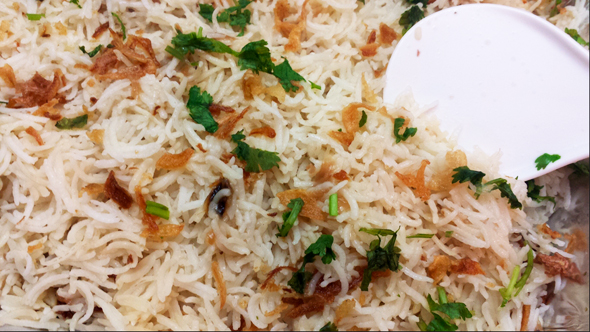Mama’s Punjabi Recipes: Bhune Pyaaz da Pulao (Spicy Sauteed Onion Pilaf)
By popular demand from many readers – and especially some younger ones – this is a reprint of Mama’s pyaaz da pulao recipe, but with some additional information and directions.
This pulao recipe is not only tasty but even while the onions and rice are being cooked, people’s mouths start to salivate! This pulao is unique because the rice comes out looking brown, but it is not made with brown rice. The rice still has the distinct taste and aroma of regular basmati rice but because of the way it is made, the pulao has an additional taste of spiced onions. The brown color of the onions runs off on to the rice, which is why I call this “brown onion rice”. This is a very Punjabi dish that is made on special occasions.
Chawal (rice) is a seed of grasses that are generally classified as Asian or African type, whereas wild rice may have evolved in Australia. Rice is normally grown as an annual plant which can grow from 3 to 6 feet tall, depending on the soil fertility. There are three types of rice grains – long, medium or short. The long remain intact after cooking; the medium becomes stickier and is used for sweet dishes or sushi; and the short is used for puddings. Instant rice is fully cooked and then dried. Rice is high in carbohydrates, has some protein and various minerals and brown rice is only higher in fiber than white rice.
The much appreciated aromatic Basmati (literally meaning “fragrant”) rice is long, slender-grained and traditionally from the Indian Subcontinent, with 65% exported by India and the rest from Pakistan. There are at least seven varieties of basmati rice.
Rice is a basic ingredient in many Indian cuisines, irrespective of which part of the country you come from. It is not eaten as much in the Punjab or other parts of Northwest India, where wheat is the staple and rice is made at special occasions like weddings, and usually prepared as a pulao (pilaf) or biryani, a similar dish, both of which can include vegetables or meats.
Pulao is a method of cooking rice in a seasoned broth and was adopted from the Persians who invaded North India three times. In some cases, the rice may become brown depending on the use of onions, a mix of spices and meat or vegetables, depending on the local cuisine. A variation of it can be found in the Middle East, Central and South Asia, East Africa, Latin America and the Caribbean.
Ingredients:
2 cups chawal (long grain rice, preferably Basmati)
2 medium pyaaz (onion)
4 cups pani (water)
2 tbsp olive oil or any other oil you prefer
1 stick daal chinni (cinnamon) – broken into 1 inch pieces
2 loung (cloves)
2 ilacchi (cardamom) – split
Namak (salt) to taste
Directions:
1. Soak the rice for 30 minutes in cold water in a wide rimmed bowl.
2. Peel the onions and cut them into thin, long slices so that the slivers come part.
3. Heat the oil in a medium sized pot and place the sliced onions in it. Stir frequently till they are dark brown, but be careful not to burn them.
4. Add the salt and cinnamon, cloves, cardamom and stir. Add the water and bring to a boil.
5. Drain the rice, then add it to the pot and bring to a boil again. Now reduce the heat to very low, cover the pot and let it simmer.
6. After about 10 minutes, the rice will rise to fill the pot. With a long fork, poke the rice to check that there is no more water on the bottom. Turn the heat off and leave the pot covered for 10 minutes.
7. Serve warm with plain yogurt, daal or rajmah (red beans) or eat simply with Indian pickles.
MAMA’S TIP OF THE WEEK
FOR TENDER BASMATI RICE, SOAK THE GRAINS BEFORE COOKING
All too often, I hear that people say they can’t cook well, that it is either too watery or too sticky, and I am confused at how they cook it. Generally they tell me that they let the rice boil for awhile and then serve it from the pot. The problem is that the starch binds the rice together when it is boiled and doesn’t allow the long-grains to show. This also affects the way the cooked rice tastes. Others stir-fry the rice in oil before adding the water, but this only keeps the rice from fluffing up completely.
The best way to cook rice – especially Basmati – is to let it soak for 30 or 45 minutes before cooking it. The water lets the rice puffs up and then most of the starch is washed off when you drain the water. Then add it to boiling water to cook. You’ll love the results!

Shakuntla Malhotra is a skilled cook of Punjabi dishes made in the old-fashioned style that she learnt as a young woman in her ancestral home in Lyallpur (since renamed Faisalabad), India before it became part of Pakistan after the Partition in 1947. People have often admired her cooking for its simplicity and taste that comes with each mouthful. Even in her mid-eighties, she continues to cook daily and agreed to share some of her delectable Punjabi recipes

